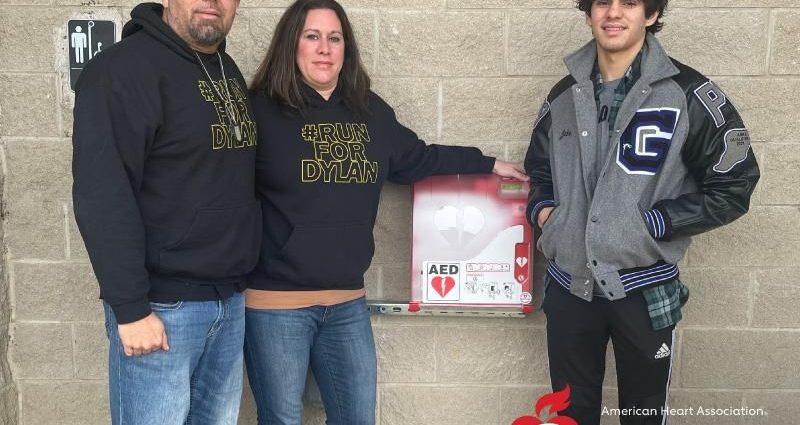TUESDAY, Jan. 31, 2023 (American Heart Association News) — Dylan Dorrell fell in love with running when he was in kindergarten and ran a 5K with his mom on Mother’s Day. As a 17-year-old senior in high school, he’d just finished practicing with his cross-country team at a local park in Denton, Texas, when he went to the bathroom to wash his hands.
He never came out.
Dylan’s heart stopped while alone in the bathroom. It was a sudden cardiac arrest.
On Aug. 13, 2020, no one was there to try saving Dylan – to call 911 or give him CPR.
So while the event itself was similar to what happened to Buffalo Bills safety Damar Hamlin during a recent Monday Night Football game, the outcome wasn’t.
“We don’t know how long he was down before he was found,” said Dylan’s mother, Lisa Dorrell. “Once he was found, CPR was started immediately by the coach and another athlete. But you saw it happen on TV (with Hamlin) and immediately CPR was started, and it makes a difference.”
Lisa, a physical education teacher, was at school for in-service training when she got the call from Dylan’s coach. They’d been friends for nearly 20 years, since from her college days. When he said, “Ms. Dorrell,” she knew something was wrong. “Dylan is unconscious,” the coach said. Faulty reception caused the call to drop.
Lisa grabbed her purse and rushed to her car. She wasn’t sure where to go, though. She called the coach’s phone and this time a paramedic answered.
“Ms. Dorrell, your son has no pulse and is not breathing,” he said.
Lisa turned on her hazard lights and kept going, somehow managing to call her husband, Gus Dorrell, and tell him to get to the hospital.
The couple arrived before the ambulance. So they watched as paramedics rushed Dylan inside. Doctors worked on him about 45 minutes, continuing CPR and administering drugs, before asking the family whether to keep trying.
“I don’t think he had a chance once he got to the hospital,” Lisa said. “I think everything they did at the hospital was for us, for our benefit.”
A few days later, Lisa called the paramedic to ask more questions – including whether an automated external defibrillator, or AED, was used to shock the heart back into a normal rhythm.
Before delivering the shock, the machine determines whether the person has a shockable rhythm. In other words, whether the jolt might revive them. The paramedic told Lisa the AED never gave that message for Dylan.
The question that haunts the Dorrells is what caused the cardiac arrest.
At 15, a heart screening showed no problems. And while the medical examiner found some scar tissue in Dylan’s left ventricle, which is believed to have come from a serious case of pneumonia in the fourth grade, she told Lisa, “This shouldn’t have caused death.”
“It still doesn’t feel right,” Gus said. “It doesn’t make you feel good when you hear that your kid is 1 in a million where this possibly happens.”
In their grief, the family started the #RunForDylan Foundation to help prevent such a tragedy from happening to another child. It also allows them to continue the legacy of their son, a quiet, quirky Star Wars fan who built his own green lightsaber by watching YouTube and using materials picked up at Goodwill. Dylan liked to sing on his nightly walks, enjoyed animation and video games and wasn’t afraid to be himself.
“He was proud of being the nerd he was,” Gus said.
“Dylan was a good kid, never caused any trouble,” Lisa said. “We didn’t realize the effect he had on others until he passed. We didn’t realize he was sitting by kids at lunch that didn’t have anybody to sit with.”
Last Feb. 2, on what would’ve been Dylan’s 19th birthday, the foundation placed its first AED. It went in the most appropriate place – the park where he collapsed. This year, the family will lay flowers at the park and at a memorial tree in his honor at his elementary school. Then they plan to eat Dylan’s favorite lunch (pizza and Dr Pepper) and visit a vintage toy store because Dylan collected vintage Transformers.
The foundation began an annual #RunForDylan 5K to raise money and awareness about cardiac arrest and the importance of CPR and AEDs. They plan to donate three more AEDs at two of Denton’s largest parks. Lisa, a CPR instructor, has also taught CPR to at least 50 people.
When Hamlin collapsed during the nationally televised football game, Lisa’s phone buzzed with texts and Gus felt like he was experiencing a sort of post-traumatic stress disorder. They are grateful for Hamlin’s recovery and at the same time grateful for the spotlight on a cause they are so passionate about.
“I don’t know if Damar even realizes what he’s done for people like us,” Gus said. “There’s a lot of families like us trying to spread the word, awareness, do good things, and in one swoosh, there we are, and America’s aware now.”
American Heart Association News covers heart and brain health. Not all views expressed in this story reflect the official position of the American Heart Association. Copyright is owned or held by the American Heart Association, Inc., and all rights are reserved. If you have questions or comments about this story, please email editor@heart.org.
By Stefani Kopenec, American Heart Association News
Copyright © 2025 HealthDay. All rights reserved.

